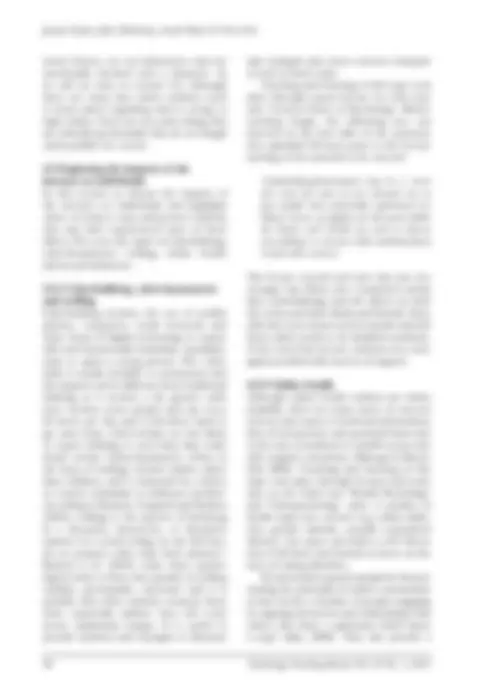





Study with the several resources on Docsity

Earn points by helping other students or get them with a premium plan


Prepare for your exams
Study with the several resources on Docsity

Earn points to download
Earn points by helping other students or get them with a premium plan
Community
Ask the community for help and clear up your study doubts
Discover the best universities in your country according to Docsity users
Free resources
Download our free guides on studying techniques, anxiety management strategies, and thesis advice from Docsity tutors
The potential risks and challenges psychology students face while learning about cyberpsychology, including exposure to upsetting or illegal content, questioning their morality, and experiencing harassment or hacking. Recommendations are provided for academics to ensure student support and protection. Keywords: Cyberpsychology, sensitive issues, online behavior, online dangers, online morality.
What you will learn
Typology: Study notes
1 / 7

This page cannot be seen from the preview
Don't miss anything!




In contrast to the helpful sources of guidance and regulations for researchers designing and conducting experiments in cyberpsychology, there is very little guidance available for academics and teachers teaching sensitive issues related to behavior in the online world. There are many potential dangers for psychology students when learning about cyberpsychology, ranging from being exposed to upsetting or illegal behaviour viewed in videos or images, to questioning their own sense of morality and understanding of self, to experiencing harassment or hacking. This paper will highlight our own experiences of teaching cyberpsychology to first and third year psychology students, highlighting some of the potential dangers. We suggest recommendations for academics to ensure that students are protected as far as is possible. Keywords: Cyberpsychology; sensitive issues; online behavior; online dangers; online morality.
HERE IS NO SHORTAGE of research investigating the impacts of technology and the internet and many sensitive topics are explored in this research (e.g. Attrill, 2015). Online research can pose many challenges in adhering to existing ethical principles in psychology (BPS, 2014) and in 2013, the BPS published Ethics Guidelines for Internet-mediated Research to address these challenges. However, although some of these principles are relevant to both teaching and research, there is very little ethical guidance specifically for teachers of cyberpsychology. There are many potential dangers for psychology students when learning about cyberpsychology. The many examples of students and children being exposed to upsetting or illegal videos and images during online researching are identified by the extensive European-wide review and survey conducted by Livingstone et al. (2011). However, less visible and under-researched impacts also include students questioning their own moral compass and understanding of their self or identity when engaging with sensitive materials online. Negative commu- nication such as harassment or hacking may be experienced following participation in social media through posts or tweets. Exam- ples of these emotional, behavioural and cognitive effects will now be discussed.
This article will highlight our experiences teaching cyberpsychology to undergraduate psychology students and will discuss the ways that we have guided and supported them. Section 2 is divided into three parts: section 2.1 will explore the motivations that lead to people behaving in a deviant or deceptive way online; next (section 2.2) we explore the impacts of the internet on individuals and cover the topics of cyberbullying, cyber- harassment, trolling, online health and sexual behavior; finally in section 2.3 we discuss many of the moral and legal issues involved when teaching cybersecurity. In section 3, we summarise our recommendations for academics to help to ensure that students are supported and protected when learning about sensitive issues in the online world.
We will highlight our experiences teaching sensitive issues to undergraduate psychology students; the majority of examples come from experiences within our final year unit ‘Cyberpsy- chology’, but also from teaching a guest lecture on a first year unit on ‘Current Issues in Psychology’ and other final year units in ‘Forensic Psychology’ and ‘Health Psychology’. Within each section we highlight ways that we
Teaching sensitive issues in cyberpsychology
have protected, guided and supported students with the specific issues that could arise.
One of the areas that researchers have inves- tigated is the motivations behind online devi- ance. A number of approaches exist, each focussing on different aspects to explain deviant behaviour; some approaches draw on the media, others on the group context and others on individual characteristics. Suler (2004b) identifies the ‘online disinhi- bition effect’ to explain many of the effects and this approach has been applied widely over the last 15 years. Teaching and learning mainly took place through online asynchronous discussions within a third year Cyberpsychology unit. Before teaching began the following text was placed on the presentation slides 48 hours prior to the lecture warning of the material to be covered:
‘When researching the topic of deviance, please be mindful that online searching could result in things you wish you had not seen. There- fore, please think carefully regarding your search terms, consider filters and think care- fully before clicking on any links. Remember your digital path can always be tracked. If you do come across anything which makes you feel uncomfortable, please inform the appropriate service (such as CEOP, IT support) or discuss with BU counselling.’
Issues that were debated within the online discussions included: differences between online and offline deviance; online iden- tity deception and persuasion involved in grooming or scamming, and Munchausen by Internet (MBI) where fake sufferers discuss their illnesses via social media (Pulman & Taylor, 2012). Online student discussions have many advantages over face-to-face discussions in teaching (Taylor, 2002), especially if students can communicate separated by space or time (i.e. asynchronously). For example,
they encourage more interactivity and are less likely to be dominated by one or two students, compared to face-to-face discus- sions (Herring & Stoerger, 2014). Although not anonymous, online discussions provide a forum where it is possible for students to be less inhibited. Suler (2004a) defines this as the ‘online disinhibition effect’ because without having to deal with face-to-face encounters, people can express themselves more openly. Students who are socially anxious often find online discussions to be more enjoyable (Taylor, 2002) as they reduce anxieties around negative evaluation from others. Asynchronous online discussions can allow students to be their true selves, however this does not come without risks relating to self-disclosure and therefore students need to be warned about this possible effect and the online discussion board should be set up so that students can delete their own messages. Savin-Baden et al. (2013) inves- tigated student disclosure when they were asked to respond candidly to a lifestyle choices online survey and found correla- tions between a user’s sense of trust, levels of truthfulness and engagement. An issue for future consideration is that as students took part in the online discussions asynchro- nously they may not have support available should they experience an uncomfortable topic or feeling. Many students participated outside of the working day, often late at night, when tired or potentially under the influence of alcohol or drugs which could affect perceptions or behaviour. The wider issue of morality in videogames provoked much discussion. Videogames now have advanced graphics so that for many players the gap between reality and fantasy is closing; the impact of playing through a character in first person shooter type games means that players can control or act out behaviours. These behaviours can be illegal, although Gibbons (2009) proposed that avatar activity was only illegal if it affected real life. Despite this, cognitive, emotional and behavioural components of morality are observed in video games: players make
Teaching sensitive issues in cyberpsychology
good topic for students to engage in healthy debate. Csipke and Horne (2007) report that media representations of pro-anorexia are sensationalising and are often a key motivator for people to visit the sites. Thus, the first part of the lecture includes a critical evalua- tion of the discourses conveyed in the media and highlight the inaccuracies conveyed (i.e. that the websites do not give people eating disorders or try to ‘recruit’ anorexics!). We then focus on a reason that people use pro- anorexia websites, i.e. as a way of communi- cating with others who also see their eating disorder as a coping mechanism or playing some other functional role (Williams & Reid,
Teaching and learning of this topic took place during the third year ‘Forensic Psychology’ and ‘Cyberpsychology’ units. A number of sensitive issues are covered including the rela- tionship between sex offending and online porn, sexting, revenge porn and online misogynistic communications. To support one lecture, a film showing psychological techniques for grooming was followed by students discussing the dangers that young people may be exposed to when using the internet. Students were asked to consider
UK and international legislation and then explored educational moves to protect chil- dren. This led to wider discussions about the growing trade in indecent child images from adults and also the exchange between chil- dren in the form of sexting. An area of teaching which required specific consideration regarding this topic was in relation to supervision of final year projects. Obviously the majority of students wish to complete projects that are of particular interest to them and these can involve sensitive topics; sometimes this interest stems from personal involvement or victimisation, for example in relation to sexting behaviour or revenge pornography. Whilst not wanting to dampen enthusiasm for research topics of interest, staff were reminded of their duty of care for students. As such open and honest communication is essential, within an environment of profes- sional collaboration and sharing where all factors which may impact the study (and any disagreements or misunderstandings) are openly discussed. In particular students were explicitly asked if there was anything the supervisor should be made aware of in their personal background which may affect their considerations. It can be explained to the student that whilst we do not want to restrict research interests, their aim is to learn to become objective scientists and as such any potential bias/preconceptions should be explicitly articulated. In addition giving students different options is suggested – they can talk to the supervisor or others, consider an alternate project, amend the current one, code data in the presence of the supervisor, have more frequent supervision. Joint deci- sion making should be encouraged where possible. Personal reflections can be used by means of example to demonstrate the vulner- ability of all involved in such research, e.g. ‘ with me one day it was something innocuous – a victim had the same birthday as a good friend – it really upset me and got me thinking.’ These can be used to highlight that such feelings and empathy are normal, but the student needs to be reminded that they must discuss situa-
Jacqui Taylor, John McAlaney, Sarah Muir & Terri Cole
tions if they occur. Such projects also require an enhanced level of guidance in relation to specific ethical considerations – for example ensuring all participants are adult by utilising university populations and considering conducting pen and paper surveys, rather than online questionnaires via social media.
Many cybersecurity incidents are based around psychological manipulations of either the gatekeepers of secure systems or the victims directly; one of the most common examples being phishing emails. Within the field of computing these tech- niques are referred to as social engineering which involves the application of psycho- logical theory, particularly those from social, consumer and cognitive psychology. Teaching psychology students about how their skills can be applied to cybersecurity has some risks. It may involve introducing them to topics and activities of varying legality that they themselves may decide they wish to be involved in. This could include clear cybercriminal activities such as obtaining credit card details, or it may involve behav- iours such as hacktivism, which refers to using online technologies as a form of social protest to, for example, disrupt a website. This latter type of activity may be some- thing that social science students such as psychology students may be especially likely to decide they wish to engage with. By its nature hacktivism often involves a minority group presenting itself as being in competi- tion with a larger oppressor, whom the hack- tivists typically portray as being unethical in nature. Examples would include multina- tional companies or foreign governments who may been seen to act in an unethical way. It may be difficult for students to remain impartial in these situations. Even if a student only intends to explore this phenomenon for research purposes they may inadvertently place themselves at risk. The actions associ- ated with hacktivism are often illegal and, whilst the damage contributed by each indi- vidual involved may be relatively low, it has
been suggested that some targeted organisa- tions have aggressively pursued legal action against any individuals (many of whom are college students) who are involved in any way in these activities (Olson, 2012). Teaching this topic also involves exposing students to technologies and activities that they may not be aware of. This includes the dark web, which refers to a part of the internet than cannot be accessed through well-known browsers such as Chrome or Internet Explorer. Instead it can only be accessed using specific software such as Tor. When correctly used, this software can be used to preserve anonymity in a way that is not possible when using other web browsers. Use of this software is not in itself illegal – indeed it was developed by the United States Naval Research Laboratory and is used by government agents, journalists and others as a way of communicating securely and secretly (Bartlett, 2014). However, the dark web includes a number of sites which include highly illegal and potentially distressing material, including sales of illicit drugs and child pornography. The dark web is not as user friendly as the surface web and as a result there can be little indication of what a website contains before a link on the dark web is opened. An inexperienced user could for instance easily and unwittingly open a child pornography website. Teaching and learning of this topic took place through lectures and seminars on the third year ‘Cyberpsychology’ unit. To prepare students for this topic the teaching sessions begins with a clear and direct explanation of the risks involved in engaging with the behaviours that were to be discussed and presented. Students were reminded that crimes committed online such as fraud are treated as seriously as offline crimes. Simi- larly, examples are given of individuals, specif- ically students, who took part in hacktivism campaigns for ideological reasons (with no financial gain) who were subsequently arrested and prosecuted. Nevertheless no statement is made to the students about what they should or should not be involved in
Jacqui Taylor, John McAlaney, Sarah Muir & Terri Cole
Attrill, A. (2015) Cyberpsychology. Oxford: Oxford University Press. Bartlett, J. (2014). The dark net. London: William Heinemann. BPS (2013). Ethics guidelines for internet-mediated research. Retrieved 18 February 2017 from the BPS website: https://beta.bps.org.uk/sites/beta. bps.org.uk/files/Policy%20%20Files/Ethics% Guidelines%20for%20Internet-Mediated% Research%20%282013%29.pdf BPS (2014). Code of Human Research Ethics. Retrieved on 18 February 2017 from the BPS website: http://www.bps.org.uk/system/files/Public% f i l e s / c o d e _ o f _ h u m a n _ r e s e a r c h _ e t h i c s _ dec_2014_inf180_web.pdf Brotsky, S.R. & Giles, D. (2007). Inside the ‘pro-ana’ community: A covert online participant observa- tion. Eating Disorders , 15, 93–109. Buckels, E.D., Trapnell, P.D. & Paulhus, D.L. (2014). Trolls just want to have fun. Personality and Indi- vidual Differences , 67, 97–102. Csipke, E. & Horne, O. (2007). Pro-eating disorder websites: Users’ opinions. European Eating Disor- ders Review , 15, 196–206. Gibbons, L.J. (2009). Law and the emotive avatar. Vanderbilt Journal of Entertainment & Technology Law , 11 (4), 899–920. Gibbs, J.C., Basinger, K.S. & Fuller, D. (1992). Moral maturity: Measuring the development of sociomoral reflection. Hillsdale, NJ: Erlbaum. Herring, S.C. & Stoerger, S. (2014). Gender and (a)nonymity in computer-mediated communica- tion. In S. Ehrlich, M. Meyerhoff, & J. Holmes (Eds.), The handbook of language, gender, and sexu- ality, 2nd edn, (pp.567–586). Chichester: John Wiley & Sons.
Kanuga, M. & Rosenfeld, W.D. (2004). Adolescent sexuality and the internet: The good, the bad, and the URL. Journal of Pediatric & Adolescent Gynecol., 17 (2),117–24. Kim, A.J. (2000). Community building on the web: Secret strategies for successful online communities. Berkeley, CA: Peachpit Press. Kohlberg, l. & Kramer, R. (1969). Continuities and discontinuities in childhood and adult moral development. Human Development, 12 , 93–120. Livingstone, S., Haddon, L., Görzig, A. & Ólafsson, K. (2011). Risks and safety on the internet: The perspec- tive of European children. Retrieved 18 February 2017 from: http://eprints.lse.ac.uk/33731/ Olson, P. (2012). We are anonymous. New York: Back Bay Books. Pulman, A. & Taylor, J. (2012). Munchausen by Internet (MBI). Journal of Medical Internet Research. 14 (4) , e115 doi:10.2196/jmir. Savin-Baden, M., Tombs, G., Burden, D. & Wood, C. (2013). ‘It’s almost like talking to a person’: Student disclosure to pedagogical agents in Sensitive Settings. International Journal of Mobile and Blended Learning , 5 (2), 78–93. Suler, J. (2004a). In class and online: Using discus- sion boards in teaching. CyberPsychology & Behavior, 7 (4), 395–401. Suler, J. (2004b). The online disinhibition effect. Cyberpsychology & Behavior , 7 , 321–326. Taylor, J. (2002). A review of the use of asynchro- nous e-seminars in undergraduate education. In R. Hazemi, S. Hailes and S. Wilbur (Eds.), The digital university (pp.125–138). London: Springer-Verlag. Williams, S. & Reid, M. (2007). A grounded theory approach to the phenomenon of pro-anorexia. Addiction, Research & Theory , 15 (2), 141–152.